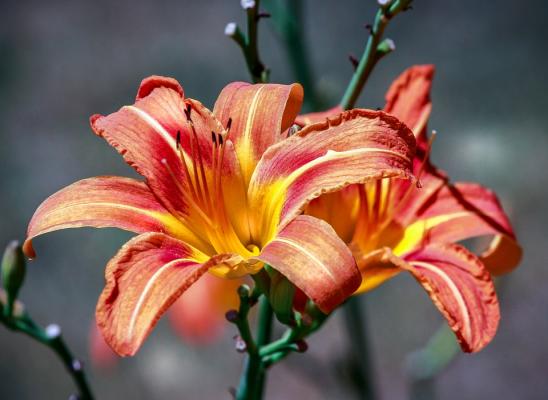By Beatrice Hawkins
As I wrote this early in the week the whole town was enveloped in the most amazing and beautiful fog. So long as I don’t have to drive in it I love fogs, especially where my current house is situated. From my spot on the hill I can’t see or hear anything of town and even my close neighbours are barely visible! The only sounds are magpies singing as they start the day and the cooing of doves – wonderful! Later as it lifts the spire of St Marys will poke through and gradually all will be revealed again. Dressed warmly and with a hot drink in hand, it is one of my life’s pleasures to watch unfold from the front patio.
The rain at the weekend was great and my gauge said 20mm, so my garden says a big thank you and so do I – it certainly beats carrying shower water onto it.
One of the joys of winter in the garden is being able to read catalogues and gardening books and dream of what is to come in Spring!
Daylilies have captured my attention this week as the ones in my garden are still growing well and did flower well during the summer. I have decided I need more of these very hardy perennials so started reading and dreaming.
There are three types of daylilies – evergreen, semi-evergreen and dormant and two genetic forms, diploid and tetraploid. Now the types are pretty self explanatory, but the genetic description left me scrambling! Apparently a “tetraploid” is more vigorous and has larger flowers.
Daylilies form clumps of strappy leaves and then spikes of flowers with many buds along them. Each flower only lasts a day, hence the name, but with as many as 20-plus buds per stem and many stems per clump, you’ll have a long period of enjoyment.
They come in an amazing array of colours, sizes and shapes from the simple plain orange ones that were my introduction to them many years ago, to doubles, bi-colours, spiders and miniatures and some varieties are even perfumed.
Evergreen varieties will grow almost anywhere in Australia, semi-evergreens like to have cooler winters and dormant varieties like cold winters and frequent frosts. They really are a flower that has a place in any garden in our area with probably the semi- evergreens being the most suitable. They are remarkably drought-tolerant, so once again are ideal for our area with our limited water supply.
They can be planted at any time of the year, but it is best to get them in between March and October, so now is ideal. Full sun is best, but part shade is alright so long as they get at least six hours of sun a day. As with most plants, good friable, compost rich soil is best and mulch around them. Depending on their final size they can be planted anywhere from 30-90cm apart. Water once a week until established but be careful not to over water in the early weeks as they can rot. Even though they are drought tolerant, watering once a week when they are flowering is recommended and once a month during the winter.
While it is nice to see them in bloom when you are buying them, you’ll have to rely on the accuracy of the catalogue or tag just now.
From my experience they are fairly pest and disease free with my major problem being the ever present snails and slugs that can make the leaves look messy – constantly working on getting rid of these pests!
After 3 or 4 years if the clumps become too large, or if you need a new clump in another spot, they can be split, preferably between about April and September, using a sharp shovel. The relocated clump may take a while to flower in the new spot, so be patient and feed them in the spring and they will delight you.
I have been looking in catalogues and on the internet and my big problem now is which ones do I choose! The range of colours, shapes and sizes is amazing and some of the bi-colours and ruffled edge ones are spectacularly fabulous and flamboyant. As I don’t have a lot of room to fill it will be a very difficult decision.
With the rain at the weekend that seems to have been fairly consistent in the area, our gardens have been given a much needed boost.
Once again – don’t forget to plan for the annual garden competition in October!







